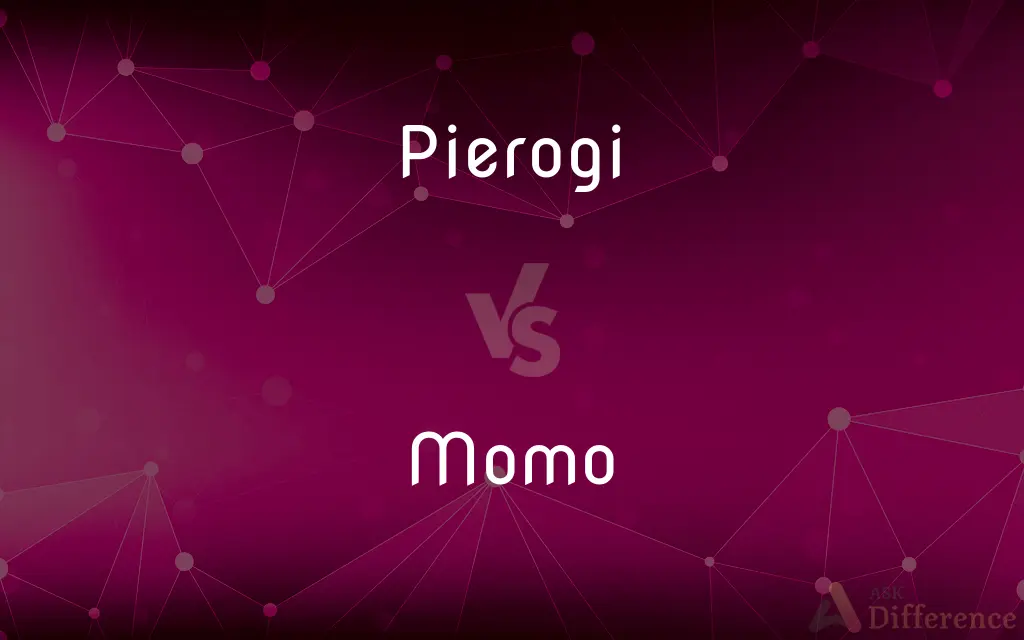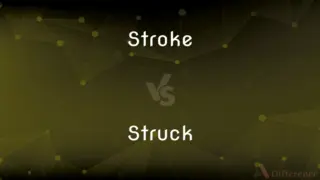Pierogi vs. Momo — What's the Difference?
Edited by Tayyaba Rehman — By Fiza Rafique — Updated on April 27, 2024
Pierogi, a staple of Eastern European cuisine, are dough dumplings typically filled with potato, cheese, or meat, and are boiled or fried. Momos, originating from Tibet, are similar dumplings but are usually steamed and filled with meat or vegetables.

Difference Between Pierogi and Momo
Table of Contents
ADVERTISEMENT
Key Differences
Pierogi are traditional Eastern European dumplings made from unleavened dough, filled with a variety of ingredients such as mashed potatoes, cheese, and sometimes meat. Whereas, momos are a type of dumpling that comes from Tibet and are commonly found in the cuisine of Nepal, Northeast India, and regions where Tibetan diaspora resides. The filling for momos often includes minced meat, vegetables, or cheese, and they are characteristically steamed.
Pierogi are often served with toppings like onions, sour cream, or bacon bits to enhance their flavor. On the other hand, momos are typically accompanied by a spicy dipping sauce made from tomatoes, chilies, and various spices, reflecting the vibrant flavors typical of South Asian cuisine.
The dough of pierogi is usually thicker and can be either boiled or fried, giving it a soft or crispy texture. In contrast, momo dough is generally thinner and primarily steamed, resulting in a tender and juicy bite that encapsulates the filling.
Pierogi fillings are commonly simple and hearty, focusing on combinations like potato and cheese or meat. However, momos may include a mix of ground meat, vegetables, and aromatic herbs and spices, offering a burst of flavor with each bite.
Culturally, pierogi are often associated with family gatherings and festive celebrations in Eastern Europe, symbolizing comfort food. Meanwhile, momos are a popular street food in regions of the Himalayas, served in both casual and celebratory settings, reflecting their integral role in local daily diets and social life.
ADVERTISEMENT
Comparison Chart
Origin
Eastern Europe
Tibet
Cooking Method
Boiled or fried
Steamed
Typical Fillings
Potato, cheese, meat
Meat, vegetables, cheese
Dough Thickness
Thicker
Thinner
Cultural Significance
Festive food, family gatherings
Street food, widely popular in daily diet
Compare with Definitions
Pierogi
Often filled with a mixture of potato, cheese, or meat.
We had pierogi filled with ricotta and spinach at the dinner.
Momo
Primarily steamed, although sometimes fried or baked.
The street vendor served us freshly steamed momos with a spicy sauce.
Pierogi
A type of dumpling made from unleavened dough.
My grandmother makes the best potato and onion pierogi during the holidays.
Momo
Usually served with a spicy dipping sauce.
The tomato-based dipping sauce made the momos even more delicious.
Pierogi
Can be served boiled or fried, based on preference.
I prefer my pierogi fried until they're crispy on the outside.
Momo
Filling typically includes minced meat, vegetables, and spices.
Vegetable momos are a great option for vegetarians looking for a tasty snack.
Pierogi
A traditional dish in Eastern European cuisine, especially in Poland.
Pierogi are a staple at many Polish festivals and family gatherings.
Momo
A type of South Asian dumpling originating from Tibet.
Momos are often filled with spiced meat and steamed to perfection.
Pierogi
Commonly topped with onions, sour cream, or bacon bits.
He topped the pierogi with a generous dollop of sour cream.
Momo
Popular in the cuisines of Nepal and Northeast India.
During my trip to Kathmandu, I tried some authentic buffalo meat momos.
Pierogi
Pierogi ( pih-ROH-ghee) are filled dumplings made by wrapping unleavened dough around a savoury or sweet filling and cooking in boiling water. They are often then pan-fried before serving.
Momo
A type of dumpling from Nepal, Ladakh or Tibet made with a simple flour and water dough and filled with meat, vegetables or cheese.
Pierogi
A semicircular dumpling with any of various fillings, such as finely chopped meat or vegetables, that is often sautéed after being boiled.
Momo
A moron.
Pierogi
(North America) A square- or crescent-shaped dumpling of unleavened dough, stuffed with sauerkraut, cheese, mashed potatoes, cabbage, onion, meat, or any combination of these, or with a fruit filling.
Common Curiosities
What are pierogi made of?
Pierogi are made from unleavened dough and are typically filled with potato, cheese, or meat.
How are momos cooked?
Momos are usually steamed, though they can also be fried or baked.
Can pierogi be considered a vegetarian dish?
Yes, pierogi can be vegetarian, often filled with combinations like potatoes and cheese.
What makes momos different from other dumplings?
Momos are unique primarily due to their thin dough and the spicy dipping sauce they are served with.
What is the best way to serve momos?
The best way to serve momos is steamed with a side of spicy tomato and chili sauce.
Can momos be made without meat?
Absolutely, vegetable momos are popular and include finely chopped seasonal vegetables.
Are pierogi easy to make at home?
Making pierogi at home can be time-consuming but is quite straightforward with practice.
Do pierogi have a cultural significance?
In Eastern Europe, particularly Poland, pierogi have a deep cultural significance and are often associated with family and holiday celebrations.
Where are pierogi most popular?
Pierogi are incredibly popular in countries like Poland, Ukraine, and other parts of Eastern Europe.
Is there a dessert version of pierogi?
Yes, sweet versions of pierogi exist, typically filled with fruits like berries or sweetened cheese.
What types of fillings can momos have?
Momos can have various fillings, including minced meat, finely chopped vegetables, or a combination of both.
What are traditional pierogi toppings?
Traditional toppings include sour cream, fried onions, or bacon bits.
How spicy are the sauces served with momos?
The sauces can range from mildly spicy to very hot, depending on regional preferences.
How do the textures of pierogi and momos compare?
Pierogi generally have a thicker dough and can be either soft or crispy, while momos are known for their thin, tender dough.
Do momos originate from a specific region in Tibet?
Momos are believed to have originated from Tibet but quickly became a part of the wider regional cuisine in the Himalayan area.
Share Your Discovery

Previous Comparison
Dad vs. Papa
Next Comparison
Stroke vs. StruckAuthor Spotlight
Written by
Fiza RafiqueFiza Rafique is a skilled content writer at AskDifference.com, where she meticulously refines and enhances written pieces. Drawing from her vast editorial expertise, Fiza ensures clarity, accuracy, and precision in every article. Passionate about language, she continually seeks to elevate the quality of content for readers worldwide.
Edited by
Tayyaba RehmanTayyaba Rehman is a distinguished writer, currently serving as a primary contributor to askdifference.com. As a researcher in semantics and etymology, Tayyaba's passion for the complexity of languages and their distinctions has found a perfect home on the platform. Tayyaba delves into the intricacies of language, distinguishing between commonly confused words and phrases, thereby providing clarity for readers worldwide.
















































